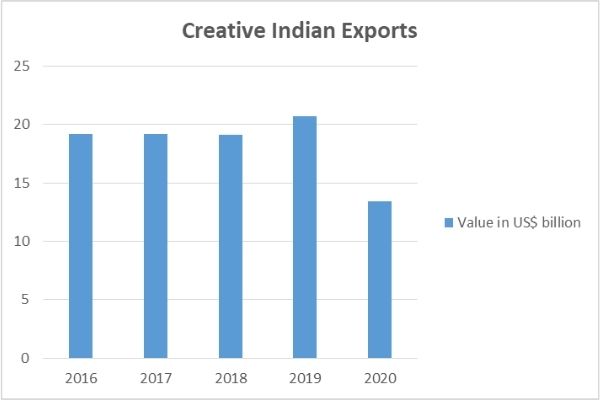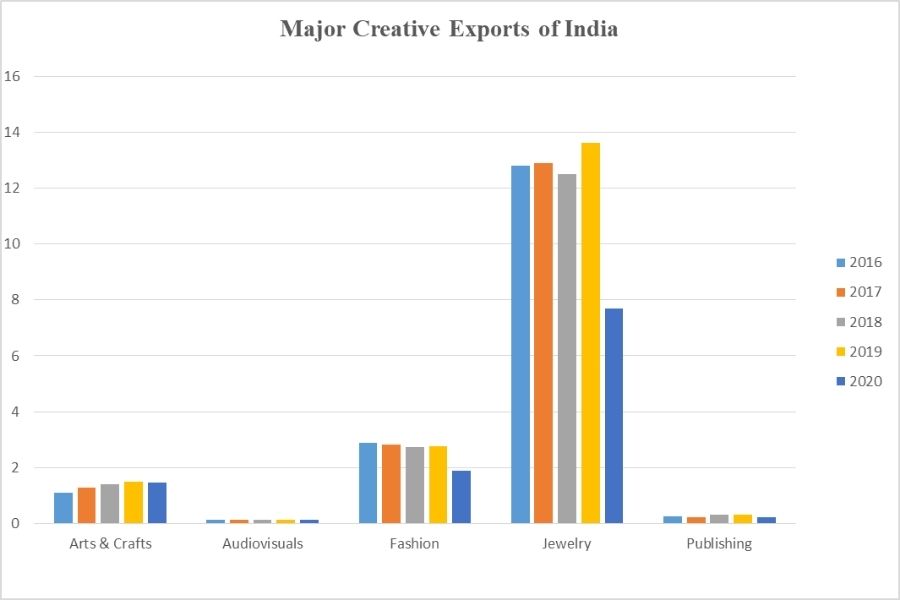Reinventing India’s creative economy in a digital era
COVID-19 has led to a sharp increase in the consumption of creative products and services on one hand, but also exposed the sector’s vulnerability on the other. Improving demographics, better access to ICTs and dynamic shifts to new lifestyles associated with creative products and services, promise a progressive future for India’s creative economy.
- Creative economy has become a significant transformative force that relies on creative resources with economic, cultural and social aspects that has the potential to facilitate economic growth.
- India has fared extensively well in the trade of these goods. The country stood at the 8th largest exporter of creative goods globally and third largest among developing countries. Indian creative exports grew from US$ 4,384 million in 2003 to US$ 26,904 million in 2012. In 2014, the country registered an export value US$ 20.2 billion.
- However, the digital divide and the poor access to stable internet connectivity and skills to utilize digital interventions in the country have been flagged as the major reason for the unprecedented downfall of certain entrepreneurs and enterprises in the creative sector.
- Electronic commerce is the pathway to a bigger marketplace for several of design products, showcase artisanal craft work and performances. These can help to rekindle India’s traditional skills and empower millions of micro-entrepreneurs and SMEs.
- Now more than ever, a culture of digital inclusion must be created to foster diversity and empower the creative industry. The COVID-19 pandemic has brought new opportunities for creative industry, turning crafts, films and digital concerts as an outlet with many people flocking in.

Image source: Pixabay
Creative economy has become a significant transformative force that relies on creative resources with economic, cultural and social aspects that has the potential to facilitate economic growth. The idea of creative goods and services in developing economies draws attention to the significant creative assets and rich cultural resources that exist in these countries.
These have manifested in the production of advertising, architecture, arts and crafts, design, fashion, film, video, photography, music, performing arts, publishing, research & development, software, computer games, electronic publishing, and TV/radio, among others.

Source: UNCOMTRADE & Author’s Calculation, figures in US$ billion
India has fared extensively well in the trade of these goods. The country stood as the 8th largest exporter of creative goods globally and third largest among developing countries. Indian creative exports grew from US$ 4.4 billion in 2003 to US$ 20.7 billion in 2019. Major exporting destinations for India with respect to such creative goods and services include United Arab Emirates, United States, China, Hong Kong, Singapore and major countries of Europe. Studies[1] have indicated a positive trade balance of creative goods with jewelry, fashion accessories and arts & crafts leading exports. The best performing sectors were design, audio-visual and publishing.

Source: UN Comtrade; Figures in US$ billion
Interventions in the telecommunications and multimedia industries, in addition to their convergence with technology, evidently have a significant impact on the demand and supply of creative goods and services. These technologies facilitate production, distribution and consumption of creative commodities. Furthermore, it has fostered new forms of artistic and creative expression.
Digitalization, thus, has brought about significant progress in the range of media, through which creative content is delivered to consumers, such as video-on-demand, music podcasting, streaming, computers and the provision of television services via cable, satellite and the Internet. The persistence of the COVID-19 pandemic has further led to exponential growth in creative digital content consumption and production.
However, it has also revealed the sector’s vulnerability. In the Covid-era, the MSMEs in the sector have contracted by around 16% and the impact on the remaining freelance and gig-workforce has been disproportional and far adverse (FICCI, 2019). Individual professionals and artisans have been witnessed to face hand-to-mouth existence surviving on food parcels and state governments micro-grants. Notably, exports dropped sharply by over 35% YoY in 2020 to reach US$ 13.4 billion.
The digital divide and the poor access to stable internet connectivity and skills to utilize digital interventions in the country have been flagged as the major reason for the unprecedented downfall of such entrepreneurs and enterprises. FICCI confirms that the long-term growth of around 90% of the creative sector has been endangered owing to the social distancing norms in the importing and exporting countries.
Evidence from UNCTAD reports suggest flourishing exports of creative goods relying on various digital forms of production and consumption. However, industries with diversified and non-virtual creative elements have not been performing optimally. It is imperative for the entrepreneurs and producing organizations in niche areas of this sector to adapt and access new audience through digital technologies.
Electronic commerce is the pathway to a bigger marketplace for several of design products, showcase artisanal craft work and performances. These can help to rekindle India’s traditional skills and empower millions of micro-entrepreneurs and SMEs, especially considering the vast population of crafts persons in the country. However, many entrepreneurs and small industry owners of such creative and cultural products lack access to internet, financial resources, and skillsets to fully utilise the digital platforms of the current age.
Remedy, in this case, can be in the form of dedicated digital skills programs to resolve long-term systemic issues for upskilling entrepreneurs to adapt to new ways of producing, distributing, and selling; collaborative efforts by the governments and institutions to facilitate digital inclusion in the industry. Moreover, increased intra-regional and cross-border trade and taking steps towards building a contingency plan to reduce non-tariff barriers and increase digital infrastructure related cooperation to facilitate and foster trade in niche creative products.
Therefore, increasing demographics, better access to ICTs and dynamic shifts to new lifestyles associated with creative products and services, promise a progressive future for this avenue.
Now more than ever, a culture of digital inclusion must be created to foster diversity and empower the creative industry. The COVID-19 pandemic has brought new opportunities for creative industry, turning crafts, films and digital concerts as an outlet with many people flocking in.
[1] United Nations Conference on Trade and Development (2018). Creative Economy Outlook: Trends in International Trade in Creative Industries
https://unctad.org/system/files/official-document/webditcted2016d5_en.pdf
References:
- World Bank (2021). The Asian Economies Bounce Back but Face Fragile Recovery: https://www.worldbank.org/en/news/press-release/2021/03/31/south-asian-economies-bounce-back-but-face-fragile-recovery
- Jackson, J. K. (2021). Global Economic Effects of COVID-19. Retrieved from Congressional Research Services: https://fas.org/sgp/crs/row/R46270.pdf
- WTO. (2021). Press/876 Press Release: World trade primed for strong but uneven recovery after COVID-19 pandemic shock. Retrieved from World Trade Organization (WTO): https://www.wto.org/english/news_e/pres21_e/pr876_e.htm
- Carboni et al (2021). Connected Women: The Mobile Gender Gap Report. Global System for Mobile Associations: https://www.gsma.com/r/wp-content/uploads/2021/07/The-Mobile-Gender-Gap-Report-2021.pdf
- United Nations Conference on Trade and Development (2018). Creative Economy Outlook: Trends in International Trade in Creative Industries
- United Nations Conference on Trade and Development (2015). Creative Economy Outlook: Trends in International Trade in Creative Industries
- Nhaissi (2019). Why It’s Time for Women in Creative Industries to Move The Needle. YEC Women Council Post, FORBES.
- Federation of Indian Chambers of Commerce & Industry. Creative Economy, Nation Building: Higher Education as a catalyst. https://ficci.in/spdocument/23151/Creative-Economy-Report.pdf
- UNCTAD (2008). Creative Economy Report 2008: The challenge of assessing the creative economy towards informed policy-making













Leave a comment